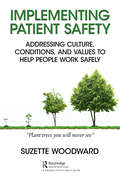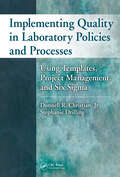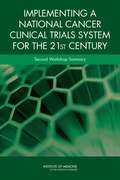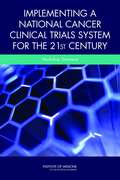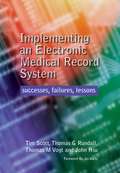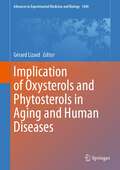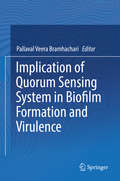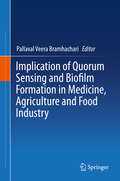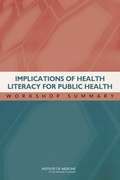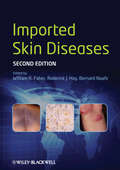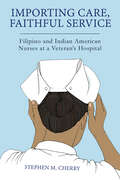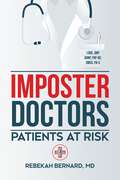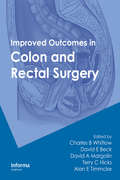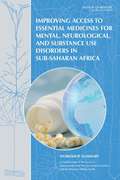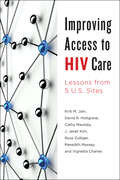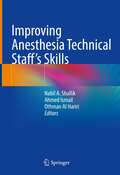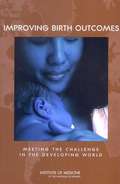- Table View
- List View
Implementing Patient Safety: Addressing Culture, Conditions and Values to Help People Work Safely
by Suzette WoodwardOver the last two decades across the globe we have seen a multitude of programs, projects and books to help improve the safety of patient care in healthcare. However, the full potential of these has not yet been reached. Most of the current approaches are top down, programmatic and target driven. These look at problems in isolation one harm at a time with simplistic solutions that fail to support a holistic, systematic approach. They are focused on collecting incident data and learning from failure using tools that are not fit for purpose in a complex nonlinear system. Very rarely do the solutions help build the conditions, cultures and behaviours that support a safer system and help the people involved work safely. Healthcare is stuck in a relentlessly negative approach to safety. Those working in patient safety and healthcare are struggling, and books on patient safety to date instruct the reader to continue doing the same things we have been doing for the last 20 years. This book uniquely combines the latest thinking in safety, including creating a balanced approach to learning from what works as a way to understand why it fails, together with the evidence on building a just culture, positive workplaces and working relationships that we now know are so important for safety. It helps people understand how to address issues despite their complexities and improve safety with practical ways to truly understand what day to day healthcare work is actually like, rather than what people imagine it is like. This book builds on the author’s first book Rethinking Patient Safety which exposed what we need to do differently to truly transform our approach to patient safety. It updates the reader further on the concepts explored in the first book but also vitally helps readers understand the ‘how’. Implementing Patient Safety goes beyond the rhetoric and provides the reader with ideas and examples for how the latest thinking can actually be achieved. It is based on the author’s personal experience of leading a national culture change campaign in the National Health Service for five years. The lessons arise from helping hundreds of organisations and people rethink and implement a whole new way of thinking about improving patient safety in healthcare.
Implementing Quality in Laboratory Policies and Processes: Using Templates, Project Management, and Six Sigma
by Donnell R. Christian Jr. Stephanie DrillingIn order to gain accreditation, every laboratory must have a superior quality assurance program. The keys to a successful program are the operational and technical manuals and associated documents which define the program and its various components. Written by experts with global experience in setting up laboratories, Implementing Quality in Labora
Implementing Transference-Focused Psychotherapy Principles: General Psychiatric Care for Personality Disorders
by Richard G. Hersh Chiara De PanfilisThis book focuses on the practical utility of key precepts of Transference-Focused Psychotherapy (TFP) in contemporary psychiatry. This volume actively addresses the pressing public health crisis related to high numbers of patients with personality disorder pathology, often with significantly compromised functioning associated with marked social burdens related to health costs and lost productivity. TFP is one of the empirically validated treatments for patients with borderline personality disorder (BPD). Building on this evidence base, the contributors to this volume describe their work in multiple clinical situations utilizing these principles with varying patient populations in different treatment settings. These settings include: the adult and adolescent day hospital, short term and extended inpatient hospitalizations, group therapy, and a range of outpatient services. Each chapter follows a consistent format to cover patient population, nature of treatment setting, overview of financial support, training of clinicians, treatment targets, elements of TFP employed, measurement of effectiveness, case study examples, and future research goals. Contributors from different backgrounds describe active use of TFP principles in their work, with adjustments from standard TFP protocol made accordingly. Implementing Transference-Focused Psychotherapy Principles builds on the growing literature about TFP by expanding the focus beyond the extended individual psychotherapy format. The text will resonate with psychiatrists, psychologists, social workers, and mental health counselors, among others. Clinicians involved in public health systems will find the material outlined of particular value in our evolving world of mental health services.
Implementing a National Cancer Clinical Trials System for the 21st Century
by Institute of Medicine Board on Health Care Services Sharyl J. Nass Margie Patlak National Cancer Policy Forum An American Society of Clinical Oncology and Institute of Medicine WorkshopThe National Clinical Trials Network (NCTN) supported by the National Cancer Institute (NCI) has played an integral role in cancer research and in establishing the standard of care for cancer patients for more than 50 years. Formerly known as the NCI Clinical Trials Cooperative Group Program, the NCTN is comprised of more than 2,100 institutions and 14,000 investigators, who enroll more than 20,000 cancer patients in clinical trials each year across the United States and internationally. Recognizing the recent transformative advances in cancer research that necessitate modernization in how cancer clinical trials are run, as well as inefficiencies and other challenges impeding the national cancer clinical trials program, the NCI asked the IOM to develop a set of recommendations to improve the federally funded cancer clinical trials system. These recommendations were published in the 2010 report, A National Cancer Clinical Trials System for the 21st Century: Reinvigorating the NCI Cooperative Group Program. In early 2011, the NCPF and the American Society of Clinical Oncology (ASCO) held a workshop in which stakeholders discussed the changes they planned to implement in response to the IOM goals and recommendations. Two years later, on February 11-12, 2013, in Washington, DC, the NCPF and ASCO reconvened stakeholders to report on the changes they have made thus far to address the IOM recommendations. At this workshop, representatives from the NCI, the NCTN, comprehensive cancer centers, patient advocacy groups, the Food and Drug Administration (FDA), industry, and other stakeholders highlighted the progress that has been made in achieving the goals for a reinvigorated national cancer clinical trials system. Implementing a National Cancer Clinical Trials System for the 21st Century is a summary of that workshop.
Implementing a National Cancer Clinical Trials System for the 21st Century: Workshop Summary
by The National Academy of SciencesClinical trials enable scientific discoveries to advance patient care, in addition to informing and guiding subsequent research. The National Cancer Institute's (NCI's) Clinical Trials Cooperative Group Program works to advance patient care and research. The Cooperative Group Program has been instrumental in establishing the standards for cancer patient care and clinical research methods. Despite broad participation in the program, financial strain and procedural burdens limit the ability of the Cooperative Group Program to undertake medical practice-changing clinical research. Thus, the Institute of Medicine's (IOM's) National Cancer Policy Forum and the American Society of Clinical Oncology held a workshop on March 21, 2011 to follow up on the 2010 IOM report, A National Clinical Trials System for the 21st Century: Reinvigorating the NCI Cooperative Group Program, which made recommendations to strengthen the NCI Cooperative Group Program. In keeping with the established commitment to excellence Implementing a National Cancer Clinical Trials System for the 21st Centuryoutlines how to improve the current system by incorporating innovative science and trial design into cancer clinical trials. It also examines the impact of increasing quality in regards to speed, efficiency, design, launch, and conduct, as well as improving prioritization, and incentivized participation.
Implementing an Electronic Medical Record System: Successes, Failures, Lessons (Radcliffe Ser.)
by Tim Scott John Hsu Thomas Vogt Thomas RundallClinicians and managers are increasingly required to participate in or manage new initiatives which depend heavily on co-operation collaboration and a multidisciplinary approach where effective interpersonal and group skills are of vital importance. This practical guide encourages the reader to determine how their organisations work and the impact they have on their members. It draws on the experiences of primary care research and development projects and contains numerous case studies tips and techniques to manage change. It is an essential guide for healthcare professionals in primary care and will equip those working in practice and facilitators working with practices with a clear understanding of how to achieve successful acceptance and management of change.
Implementing the Mediterranean Diet: Nutrition in Practice and Public Health
by Richard HoffmanImplementing the Mediterranean Diet Implementing the Mediterranean Diet: Nutrition in Practice and Public Health situates this &‘gold standard&’ of diets within the wider food environment by bridging the gap between the evidence-based health benefits of the Mediterranean diet and its implementation. The text explores the many approaches that can be used by health professionals to help consumers adopt this healthy eating pattern, as well as the barriers encountered with implementing this diet at home and in the wider environment. It also considers sustainable food and farming practices, and national food strategies. A one-stop resource for food and health professionals, this seminal text demonstrates the full range of benefits that the Mediterranean diet can bring to society. This ground-breaking book: Gives an in-depth review of the effectiveness of the Mediterranean diet in disease prevention and the management of chronic diseases Contextualises the diet within the food environment, showing why the whole dietary pattern and minimizing the consumption of highly processed foods are both so important Shows how to implement the Mediterranean diet, motivating and guiding consumers to make the transition Addresses the practical and behavioural barriers to food choice in terms of taste, cost, variety, convenience and animal welfare concerns Implementing the Mediterranean Diet is a must-have resource for advanced undergraduate and postgraduate students in the food sciences, and for healthcare professionals such as dietitians, nutritionists, GPs, and health workers, especially those working in non-Mediterranean, high-income countries.
Implication of Oxysterols and Phytosterols in Aging and Human Diseases (Advances in Experimental Medicine and Biology #1440)
by Gérard LizardThis book provides basic knowledge of the biology, chemistry, and function of oxysterols and its derivatives as well as of phytosterols in numerous human diseases. The book is divided into six sections and begins with an introduction to the biological and chemical properties of oxysterols and its derivatives as well as phytosterols, their synthesis, and the methods currently used for their detection in various biospecimens. The following section discusses in detail the various effects of oxysterols on numerous human diseases, including infectious diseases, inflammatory and autoimmune diseases, atherosclerosis, and cancer, as well as neurological and neuropsychiatric disorders. Importantly, the potential of oxysterols as biomarkers for some of these diseases is also highlighted. The book concludes with an outlook on the pharmacological and nutritional effects of oxysterols and phytosterols and their potential use by the food, and pharmaceutical industries. Aiming to provide an in-depth overview of the biological and the chemical properties of oxysterols and phytosterols and their implications for human health, this book will be of interest to basic and clinical scientists, as well as to anyone working in the food or pharmaceutical industry who is exploring the potential of oxysterols and phytosterols.
Implication of Quorum Sensing System in Biofilm Formation and Virulence
by Pallaval Veera BramhachariThis book illustrates the importance and significance of Quorum sensing (QS), it’s critical roles in regulating diverse cellular functions in microbes, including bioluminescence, virulence, pathogenesis, gene expression, biofilm formation and antibiotic resistance. Microbes can coordinate population behavior with small molecules called autoinducers (AHL) which serves as a signal of cellular population density, triggering new patterns of gene expression for mounting virulence and pathogenesis. Therefore, these microbes have the competence to coordinate and regulate explicit sets of genes by sensing and communicating amongst themselves utilizing variety of signals. This book descry emphasizes on how bacteria can coordinate an activity and synchronize their response to external signals and regulate gene expression. The chapters of the book provide the recent advancements on various functional aspects of QS systems in different gram positive and gram negative organisms. Finally, the book also elucidates a comprehensive yet a representative description of a large number of challenges associated with quorum sensing signal molecules viz. virulence, pathogenesis, antibiotic synthesis, biosurfactants production, persister cells, cell signaling and biofilms, intra and inter-species communications, host-pathogen interactions, social interactions & swarming migration in biofilms.
Implication of Quorum Sensing and Biofilm Formation in Medicine, Agriculture and Food Industry
by Pallaval Veera BramhachariThe book illustrates the role of quorum sensing in the food industry, agriculture, veterinary sciences, and medicine. It highlights the importance of quorum sensing in regulating diverse cellular functions in microbes, including virulence, pathogenesis, controlled-gene expression systems, and antibiotic resistance. This book also describes the role of quorum sensing in survival behavior and antibiotic resistance in bacteria. Further, it reviews the major role played by quorum sensing in food spoilage, biofilm formation, and food-related pathogenesis. It also explores the methods for the detection and quantification of quorum sensing signals. It also presents antimicrobial and anti-quorum sensing activities of medicinal plants. Finally, the book elucidates a comprehensive yet representative description of basic and applied aspects of quorum sensing inhibitors. This book serves an ideal guide for researchers to understand the implications of quorum sensing in the food industry, medicine, and agriculture.
Implications of Health Literacy for Public Health: Workshop Summary
by Maria HewittHealth literacy is the degree to which individuals can obtain, process, and understand the basic health information and services they need to make appropriate health decisions. Nearly half of all American adults - 90 million people - have inadequate health literacy to navigate the health care system. Implications of Health Literacy for Public Health is the summary of a workshop convened by the Institute of Medicine Roundtable on Health Literacy in November 2013 that focused on the implications of health literacy for the mission and essential services of public health. The workshop featured the presentation of a commissioned paper on health literacy activities under way in public health organizations. Other presentations examined the implications of health literacy for the mission and essential services of public health, for example, community health and safety, disease prevention, disaster management, or health communication. This report includes the commissioned paper and summaries of the workshop presentations.
Imported Skin Diseases
by Bernard Naafs William R. Faber Roderick J. HayGlobal movement of people leads to the global movement of disease International travel enables skin diseases to move around the world with increasing ease. Skin diseases transmitted through casual contact with people, animal vectors and a foreign environment are particularly prone to transport. Dermatologists need to recognize the signs and symptoms of disease not native to their environment to enable proper diagnosis and care. Imported Skin Diseases provides a clinical guide to the foreign diseases increasingly seen in ‘Western’ clinics. With a focus on accurate diagnosis and effective therapy, the book covers: Differences between pigmented and non-pigmented skin Viral, bacterial and fungal Infections Parasitic infestations Sexually transmitted diseases Aquatic diseases Written by an international team of experts, with practical tips throughout, Imported Skin Diseases prepares you for the unusual skin diseases you are increasingly likely to see in your clinic.
Importing Care, Faithful Service: Filipino and Indian American Nurses at a Veterans Hospital (Critical Issues in Health and Medicine)
by Stephen M. CherryEvery year thousands of foreign-born Filipino and Indian nurses immigrate to the United States. Despite being well trained and desperately needed, they enter the country at a time, not unlike the past, when the American social and political climate is once again increasingly unwelcoming to them as immigrants. Drawing on rich ethnographic and survey data, collected over a four-year period, this study explores the role Catholicism plays in shaping the professional and community lives of foreign-born Filipino and Indian American nurses in the face of these challenges, while working at a Veterans hospital. Their stories provide unique insights into the often-unseen roles race, religion and gender play in the daily lives of new immigrants employed in American healthcare. In many ways, these nurses find themselves foreign in more ways than just their nativity. Seeing nursing as a religious calling, they care for their patients, both at the hospital and in the wider community, with a sense of divine purpose but must also confront the cultural tensions and disconnects between how they were raised and trained in another country and the legal separation of church and state. How they cope with and engage these tensions and disconnects plays an important role in not only shaping how they see themselves as Catholic nurses but their place in the new American story.
Imposter Doctors: Patients at Risk
by Rebekah BernardWhen you experience a medical emergency, you expect to be treated by a licensed physician with expertise in your condition. What happens when you look up from your hospital gurney to find that the doctor has been replaced by a non-physician practitioner w
Improve Your Eyesight Naturally: See Results Quickly
by Leo AngartThis title details strategies designed to improve your eyesight by literally exercising your ability to see. Leo's approach is very specific and targets each degree of vision problem. He explains how you can tone your eye-muscles, release tension, and build up energy in order to regain your natural eyesight.
Improved Outcomes in Colon and Rectal Surgery
by Charles B Whitlow David E Beck David A Margolin Terry C HicksWritten by many of the world's leading colorectal surgeons, this evidence-based text investigates the risks and benefits of colorectal surgeries. By using clinical pathways, algorithms, and case discussions, the authors identify the best practices for patient safety and positive outcomes to ensure that physicians correctly recognize potential probl
Improving Access to Essential Medicines for Mental, Neurological, and Substance Use Disorders in Sub-Saharan Africa: Workshop Summary
by Diane E. PankevichIn 2011 the Grand Challenges in Global Mental Health initiative identified priorities that have the potential to make a significant impact on the lives of people with mental, neurological, and substance use disorders. Reduction of the cost and improvement of the supply of effective medicines was highlighted as one of the top five challenges. For low- and middle-income countries, improving access to appropriate essential medicines can be a tremendous challenge and a critical barrier to scaling up quality care for mental, neurological, and substance use disorders. Reduction of cost and improvement of the supply of effective medicines has the potential to significantly impact the lives of patients with these disorders. "Improving Access to Essential Medicines for Mental, Neurological, and Substance Use Disorders in Sub-Saharan Africa" is the summary of a workshop convened by the Institute of Medicine Neuroscience Forum in January 2014 in Addis Ababa, Ethiopia to discuss opportunities for achieving long-term affordable access to medicines for these disorders. This report examines challenges and opportunities for improving access to essential medicines in four critical areas: demand, selection, supply chains, and financing and pricing. The report also discusses successful activities that increase access to essential medicines both within Sub-Saharan Africa and in other developing countries, and considers the role of governments, nongovernmental organizations, and private groups in procurement of essential medicines for mental, neurological, and substance use disorders.
Improving Access to HIV Care: Lessons from Five U.S. Sites
by Kriti M. Jain David R. Holtgrave Cathy Maulsby J. Janet Kim Rose Zulliger Meredith Massey Vignetta CharlesEffective strategies for identifying people living with HIV and helping them receive ongoing medical care.The availability of combination antiretroviral therapy has changed the lives of millions of people living with HIV (PLWH), for whom a once fatal infection can now be a manageable chronic disease. Yet only 30 percent of PLWH in the United States are virally suppressed, and significant gaps in access to care persist. While programs to boost linkage to and retention in HIV care are critical to improving the health of PLWH, efforts to evaluate these programs are surprisingly scarce. Using cutting-edge implementation science, this book tackles the issue of how to better link and retain PLWH in ongoing primary medical care. A multipart case study examines successful strategies and provides detailed profiles of the organizations involved and their processes for reaching, linking, and retaining PLWH. Barriers to and facilitators of implementation are explored qualitatively, network analysis is used to assess changes in interagency collaboration among organizations serving PLWH, and evidence-based recommendations are offered for improving linkage to HIV care in the U.S.
Improving Access to Oral Health Care for Vulnerable and Underserved Populations
by Committee on Oral Health Access to ServicesAccess to oral health care is essential to promoting and maintaining overall health and well-being, yet only half of the population visits a dentist each year. Poor and minority children are less likely to have access to oral health care than are their nonpoor and nonminority peers. Older adults, people who live in rural areas, and disabled individuals, uniformly confront access barriers, regardless of their financial resources. The consequences of these disparities in access to oral health care can lead to a number of conditions including malnutrition, childhood speech problems, infections, diabetes, heart disease, and premature births. Improving Access to Oral Health Care for Vulnerable and Underserved Populations examines the scope and consequences of inadequate access to oral health services in the United States and recommends ways to combat the economic, structural, geographic, and cultural factors that prevent access to regular, quality care. The report suggests changing funding and reimbursement for dental care; expanding the oral health work force by training doctors, nurses, and other nondental professionals to recognize risk for oral diseases; and revamping regulatory, educational, and administrative practices. It also recommends changes to incorporate oral health care into overall health care. These recommendations support the creation of a diverse workforce that is competent, compensated, and authorized to serve vulnerable and underserved populations across the life cycle. The recommendations provided in Improving Access to Oral Health Care for Vulnerable and Underserved Populations will help direct the efforts of federal, state, and local government agencies; policy makers; health professionals in all fields; private and public health organizations; licensing and accreditation bodies; educational institutions; health care researchers; and philanthropic and advocacy organizations.
Improving Anesthesia Technical Staff’s Skills
by Ahmed Ismail Nabil A. Shallik Othman Al HaririThis book showcases state-of-the-art techniques as well as various clinical, technical and non-technical skills. By highlighting the reliability of the new techniques compared to standard clinical methods of predicting peri-operative problems in the operating rooms, it enables better management and utilization of operating rooms. The combined use of knowledge and technology has resulted in improvements in healthcare services that are not achieved by the use of the best technology but by the best use of technology. Medicine is a continually advancing science, and healthcare providers constantly enhance their knowledge and develop their skills. While knowledge sharing is vital for humanity, technology has made the application of medical knowledge more versatile and more widely available. Written by leading anesthesiologists, anesthesia technicians and technologists, the book addresses the need for a ready reference for anesthesiologists, as well as anesthesia technical staff. It provides an easily navigated, pocket-sized reference resource featuring pictures, tables and schema.
Improving Animal Welfare
by Temple Grandin Jeffrey Rushen Jennifer Woods Anne De Passillé David Mellor David Main Kevin Stafford Jeff Hill Bernard Rollin Camie Heleski Janice Swanson Amy Mclean Lily Nowell Edwards Jan Shearer Helen Whay Tina WidowskiBy taking an entirely practical approach, this textbook aims to help those working with animals to apply methods for improving welfare, bridging the gap between scientific research and practical application. This book provides a guide to practical evaluation and auditing of welfare problems for farmed animals, emphasizing the importance of measuring conditions that compromise welfare such as lameness, or the use of electric goads. This second edition is fully updated with new literature, new, up to date coverage of pain management, and the addition of a new chapter on animal welfare in organic farming systems.
Improving Animal Welfare
by Temple GrandinNew legislation on animal welfare standards has created the need for welfare programmes to be implemented on farms, during transportation, and in slaughter plants. While there is a wealth of information on animal behaviour, ethics and factors effecting welfare, there is little to guide veterinarians and managers in evaluating animal welfare and improving it. This textbook aims to help those working with animals to apply practical methods for improving welfare, bridging the gap between scientific research and practical application. Drawing on the editor's extensive experience in teaching and auditing, and contributions from international experts, this book provides a guide to practical evaluation and auditing of welfare problems, emphasizing the importance of measuring conditions that compromise welfare. Key Features Written by a leading authority on the subject with contributions from industry experts Provides a strongly practical review of the topic and how to apply research where it makes a difference Ideal guide for veterinarians and veterinary students and welfare auditing and officer training, and students in animal sciences
Improving Animal Welfare: A Practical Approach
by Jeffrey Rushen Jennifer Woods Anne De Passillé David Mellor David Main Kevin Stafford Jeff Hill Bernard Rollin Camie Heleski Janice Swanson Lily Nowell Edwards Jan Shearer Helen Whay Tina Widowski Amy McLeanBy taking an entirely practical approach, this textbook aims to help those working with animals to apply methods for improving welfare, bridging the gap between scientific research and practical application. This book provides a guide to practical evaluation and auditing of welfare problems for farmed animals, emphasizing the importance of measuring conditions that compromise welfare such as lameness, or the use of electric goads. This second edition is fully updated with new literature, new, up to date coverage of pain management, and the addition of a new chapter on animal welfare in organic farming systems.
Improving Animal Welfare: A Practical Approach
by Jeffrey Rushen Jennifer Woods Anne Marie Anne Marie David Main Kevin Stafford Bernard Rollin Camie Heleski Janice Swanson Jan Shearer Helen Whay Tina Widowski Derek Donkin Amy McLean Kurt Vogel Lily N. Edwards-Callaway Madonna Benjamin Courtney Lynd Daigle Wendy K Fulwider Hubert J. Karreman David J Mellor Siobhan Mullan Steven Yik Upinder Kaur Richard M. Voyles Shawn DonkinCompletely revised, updated and with four new chapters on sustainability, new technologies, precision agriculture and the future of animal welfare, the third edition of this highly successful textbook: · Is edited by an outstanding world expert on animal welfare. · Emphasizes throughout the importance of measuring conditions that compromise welfare, such as lameness, heat stress, body condition, and bruises during transport. · Combines scientific information with practical recommendations for use on commercial operations. · Reviews practical information on livestock handling, euthanasia, slaughter, pain relief, and assessments of abnormal behavior. Improving Animal Welfare: A Practical Approach remains essential reading for students and practitioners of ethology, animal and veterinary science, veterinary medicine, as well as those working directly with farm animals and committed to improving their welfare.
Improving Birth Outcomes: Meeting The Challenge In The Developing World
by Committee on Improving Birth OutcomesBirth outcomes have improved dramatically worldwide in the past 40 years. Yet there is still a large gap between the outcomes in developing and developed countries. This book addresses the steps needed to reduce that gap. It reviews the available statistics of low birth weight, prematurity, and birth defects; reviews current knowledge and practices of a healthy pregnancy, identifies cost-effective opportunities for improving birth outcomes and supporting families with an infant handicapped by birth problems, and recommens priority research, capacity building, and institutional and global efforts to reduce adverse birth outcomes in developing countries. The committee has based its study on data and information from several developing countries, and provides recommendations that can assist the March of Dimes, Centers for Disease Control and Prevention, and NIH in tailoring their international program and forging new partnerships to reduce the mortality and morbidity associated with adverse birth outcomes.
